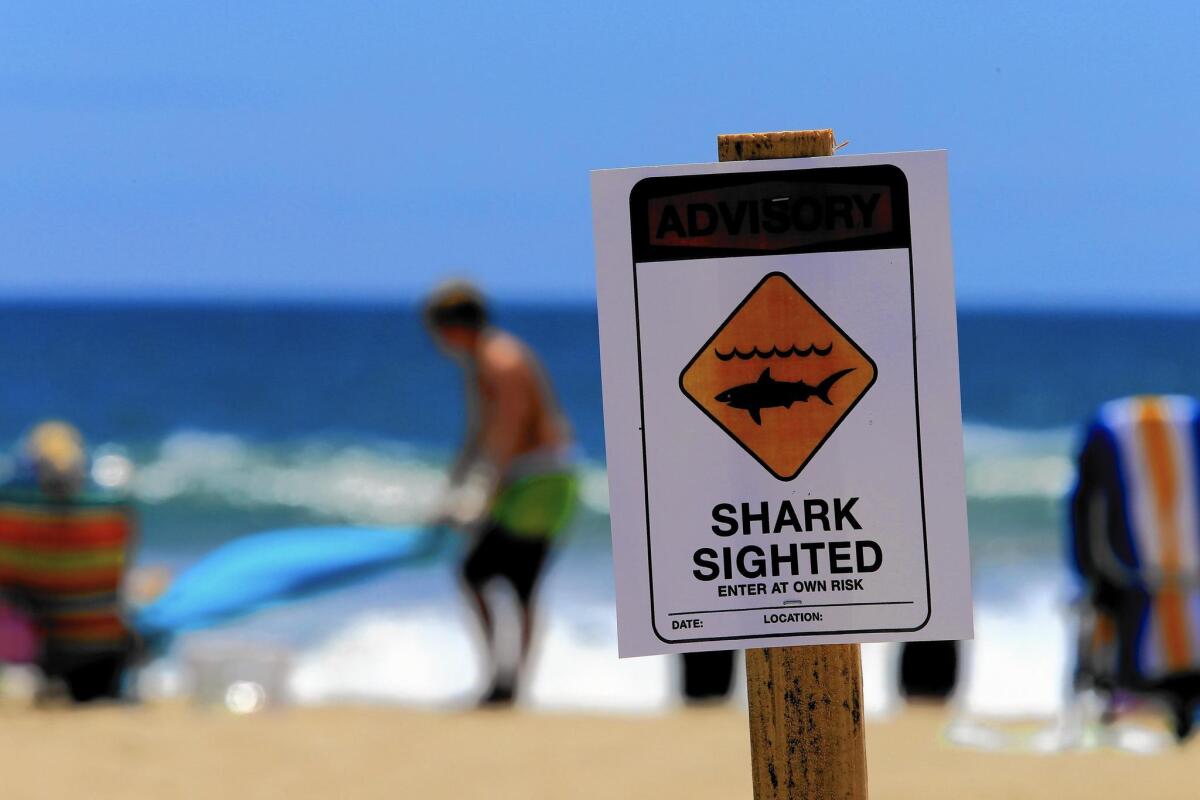Newport’s shark monitoring web page is a first for O.C.

People who flock to the sand may wonder before dipping into the ocean — are sharks lurking under the glassy surface just off the coast?
The city of Newport Beach is trying to remove some of the mystery.
On Friday, Newport became the first city in Orange County to launch a page on its website that is dedicated to logging sharks and other marine animals found near the coast. The page also has information about how lifeguards respond to shark sightings and how visitors can be safe in the water.
In July, lifeguards deployed three acoustic receivers at the Newport Pier, the Balboa Pier and in the swim lines off Corona del Mar in an effort to gather information for the site. The receivers record data from marine animals previously tagged by researchers.
When such an animal comes within 500 to 1,000 yards of one of the three devices, a transponder on the tagged animal sends a signal that the city’s device picks up and then logs the animal’s identification number for tracking.
The launch of the web page comes two months after a swimmer was bitten by what officials thought might be a 10-foot great white shark while she was swimming at Corona del Mar. Experts have pointed to warmer ocean temperatures as a reason people might be seeing more sharks in Southern California this year.
“It’s just like any other risk we have; we want to learn to educate the public,” Chief Lifeguard Rob Williams said. “If we educate ourselves and the public, maybe we can minimize the risks.”
Lifeguards are expected to pull the receivers and track the data every Monday through the summer in an effort to understand the behavior of sharks in the area, said Lifeguard Battalion Chief Mike Halphide.
The receivers will be collected more frequently if a big event, like the Junior Lifeguards Monster Mile, is planned. During nonpeak months, the receivers will be collected bimonthly or monthly.
Halphide said lifeguards scope out the water each morning for sharks or other potential dangers. The data from the receivers, he said, helps them plan how to patrol the area.
“What we’re doing is trying to understand the cross section of what’s out there so we can better adjust our procedures,” he said.
So far, the city’s Marine Animal Monitoring Log page contains details of four confirmed shark sightings in Newport Beach, one of which was discovered by the receiver in Corona del Mar. Data show that at 8:30 p.m. July 19, a 15-foot female great white shark that was tagged off the Tomales Bay in Northern California swam past the device three times in a 10-minute period.
The most recent ping on a receiver came Friday afternoon when a bat ray tagged by Scripps in La Jolla swam by the Balboa Pier.
Lifeguards say that while the devices give them insight into the behavior of tagged marine life, they aren’t without challenges.
Since the transponder on a shark transmits a signal up to 1,000 yards, it can be difficult to determine how close the shark came to shore, according to officials. Also, the information is not in real time, so there’s no way yet to know whether there’s a shark nearby when you’re taking a dip in the water.
Halphide hopes that eventually the data will be put on the website immediately after an animal swims by, but the technology has a way to go.
But the hope is that the information on the site will help more people understand all the risks associated with swimming in the ocean, officials said.
Though there is a focus on sharks, an attack is a miniscule risk compared with dangers like rip currents, Halphide said.
“Rip currents easily kill hundreds more people at the beach,” he said.
To visit the monitoring page, go to newportbeachca.gov and search for “Marine Animal Monitoring Log.”
Marine animal monitoring
Here is the log of recent recorded detections and/or confirmed sightings of marine animals off Newport Beach that are listed on the city’s Marine Animal Monitoring Log web page:
July 7: 1 p.m., Balboa Pier. Multiple confirmed reports of a shark swimming near the end of the pier. Lifeguards post an advisory, which is lifted the following day.
July 19: 8:30 p.m., Corona del Mar. Acoustic receiver logs an animal that Cal State Long Beach confirms was an estimated 15-foot female white shark tagged last year off the Tomales Bay in Northern California. The transponder on the shark sends a signal up to 1 kilometer, or about 5/8 of a mile.
July 21: 10:45 a.m., between 40th Street and the Newport Pier. Huntington Beach police helicopter crew views a small shark swimming about 100 feet offshore. Two Newport Beach lifeguard rescue boats follow the shark to the Newport Pier, where it turns out to sea. Lifeguards post an advisory, which is lifted the next day.
July 24: 6 p.m., Corona del Mar. Fishing vessel reports a large shark, about 10 feet, roughly a half-mile offshore. The sighting is confirmed by a state lifeguard vessel.
Friday: 1:39 p.m., Balboa Pier. Acoustic receiver logs an animal that Cal State Long Beach confirms was a bat ray tagged by Scripps in La Jolla.
